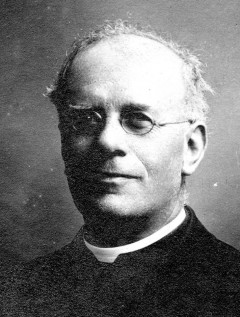Johann Peter Kirsch (1888-1890, 1926-1937/41)
Born in Dippach (Luxembourg) in 1861, the archaeologist and medievalist Johann Peter Kirsch shaped the first 5 decades of the Roman Institute of the Görres Society in two terms of office together with his colleague and friend Stefan Ehses.
As a ten-year-old boy, Kirsch (called "Jempi" [Jean-Pierre] by his friends) moved to Fels for two years to live with his priest uncle Johann Jakob Didier, who was very open-minded about art history. From there he went to Luxembourg in the autumn of 1874 to the Episcopal Convict Maria Rheinsheim to complete his secondary education at the Athenaeum there until 1880. He then transferred to the seminary. After one year of philosophy and three years of theology, he was ordained priest on 23 August 1884.
After a short chaplaincy in Dippach, the bishop sent him to Rome to study Christian archaeology, where he entered the Campo Santo Teutonico in autumn 1884 almost at the same time as Joseph Wilpert, with whom he remained in friendship throughout his life. Both wanted to research Christian antiquities, but also attended Isidoro Carini's courses at the newly founded Vatican School of Palaeography, which Kirsch completed in 1887 after three years with a diploma as Archivista-Paleografo. Since then, he also and sometimes primarily dealt with medieval manuscripts and archival projects, which Wilpert reproached him for as a departure from his archival vocation. Wilpert reproached him for this.
For the rector of the Campo Santo Teutonico, Anton de Waal (not to be confused with the Cardinal Secretary of State Rafael Merry del Val!), Kirsch was the ideal colleague: interested in archaeology and history, hard-working and organisationally gifted. He gave numerous college lectures ("Sabbatines"). He participated whenever possible in the Roman Conferences for Christian Archaeology (until 1894 under the direction of Giovanni Battista de Rossi), International Congresses of Catholic Scholars, General Assemblies of the Görres Society and later International Congresses for Christian Archaeology. He joined the Collegium Cultorum Martyrum with Wilpert on 09.12.1884 (1889-1890 secretary), was since then in contact with de Rossi and attended Mariano Armellini's lectures in Sant'Apollinare. He was also early acquainted with Heinrich Seuse Denifle O.P., from whom he "received the richest scholarly stimulation" in these first Roman years alongside de Rossi, and with Stephan Ehses, who was to become one of the most important figures of the Görres Society in Rome.
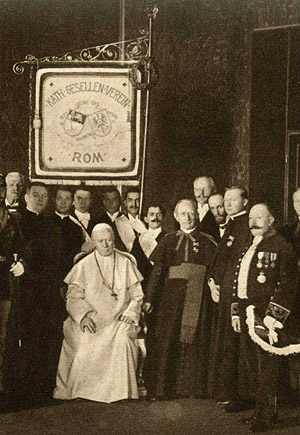 1887 he supported Anton de Waal in founding the Römische Quartalschrift. However, when he offered de Waal to be a co-editor in 1890 and the latter declined, he took over the novelty show Kunst- und Alten Kirchengesch. for the Historisches Jahrbuch. From 1900 onwards, however, he tirelessly contributed (from 1907 as co-editor) to the Römische Quartalschrift the annual Anzeiger für christliche Archäologie with current research reports and systematic bibliography until his death. In spring 1888 he studied inscriptions and catacombs with Francesco Saverio Cavallari in Syracuse and made sketches together with his future sister-in-law Olga Puricelli; in Naples he examined lead bulls. On 6 December 1888 he returned to the Campo Santo Teutonico to found and direct the Historical Institute of the Görres Society and thus escaped the exegesis professorship in Luxembourg; he conscientiously reported on the activities of the Görres Institute to the management in Cologne.
1887 he supported Anton de Waal in founding the Römische Quartalschrift. However, when he offered de Waal to be a co-editor in 1890 and the latter declined, he took over the novelty show Kunst- und Alten Kirchengesch. for the Historisches Jahrbuch. From 1900 onwards, however, he tirelessly contributed (from 1907 as co-editor) to the Römische Quartalschrift the annual Anzeiger für christliche Archäologie with current research reports and systematic bibliography until his death. In spring 1888 he studied inscriptions and catacombs with Francesco Saverio Cavallari in Syracuse and made sketches together with his future sister-in-law Olga Puricelli; in Naples he examined lead bulls. On 6 December 1888 he returned to the Campo Santo Teutonico to found and direct the Historical Institute of the Görres Society and thus escaped the exegesis professorship in Luxembourg; he conscientiously reported on the activities of the Görres Institute to the management in Cologne.
He discussed the first church-historical projects of the Görres Station (Apostolic Chamber) with Ludwig Pastor and de Rossi. As early as 1894, Kirsch dealt with the Council of Trent, which was to become an important research focus of the Institute in the future. In 1890, Kirsch was offered a full professorship in church history with a teaching assignment in patrology and Christian archaeology at the newly founded Catholic University of Fribourg. After his appointment, the papal Congregation for Studies awarded him a doctorate in theology.
On 08.07.1890 he left the Campo Santo Teutonico to go to Fribourg; his successor as director of the RIGG was Joseph Schlecht.
Kirsch held archaeological lectures and seminars in German and French, with content indebted to de Rossi. The two-year course covered clergy, cult (architecture, catacombs), private life (Caristas) and art (painting, sculpture). Kirsch illustrated his lessons with Wilpert's watercolours, plaster copies and other material, later with an episcope. His pupils included Alfred Holder from Strasbourg, Carl Maria Kaufmann, Wilhelm Schnyder, Karl Gschwind, the Dutch priest Leo Balet, who was supposed to work on early Christian representations of Peter but whom he then dropped, and the priest Max Josef Metzger from Baden, whom he tried in vain to recruit for an archaeological chaplaincy at Campo Santo Teutonico. In 1892 Kirsch had three archaeological doctoral students: on the episcopate in antiquity, the Eucharistic sacrificial elements in antiquity ("against Harnack") and the prayers and acclamations on ancient Christian inscriptions ("against Schultze"). Inscriptions ("against Schultze"). In 1926 he had six doctoral students.
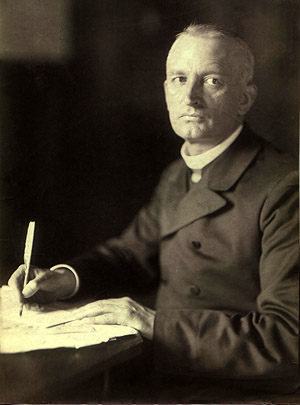 A Handbuch der Christlichen Archäologie (Handbook of Christian Archaeology), which Kirsch had already envisaged in 1891, was to be financed from his teaching material; it did not come about, nor did the work "Der Klerus in der christlichen Antike unter besonderer Berücksichtigung der archäologischen Monumente" (The Clergy in Christian Antiquity with Special Consideration of Archaeological Monuments), which had been conceived since 1893. Kirsch spent several weeks in Rome every year. On 26.09.1894 he intended to move from Fribourg to Rome and devote himself entirely to the Institute and Trento..
A Handbuch der Christlichen Archäologie (Handbook of Christian Archaeology), which Kirsch had already envisaged in 1891, was to be financed from his teaching material; it did not come about, nor did the work "Der Klerus in der christlichen Antike unter besonderer Berücksichtigung der archäologischen Monumente" (The Clergy in Christian Antiquity with Special Consideration of Archaeological Monuments), which had been conceived since 1893. Kirsch spent several weeks in Rome every year. On 26.09.1894 he intended to move from Fribourg to Rome and devote himself entirely to the Institute and Trento..
In 1900, he was instrumental in founding an archaeological department of the Roman Institute of the Görres Society under the direction of Wilperts, which in fact only existed until the First World War. In 1903, Kirsch applied in vain to succeed Franz Xaver Kraus in Freiburg. In the summer of 1910, Kirsch was in third place (after Heinrich Schrörs and Georg Pfeilschifter) on the list of the Catholic Theological Faculty of the University of Breslau to succeed August Nuernger. After Max Sdralek's death in 1913, Wilpert recommended Cardinal Kirsch from Breslau as his successor in the chair of Christian art in Breslau
In 1908, against Hermann Grauert's resistance, Georg von Hertling and Kirsch, as President of the Section for Antiquities of the Görres Society, pushed through the founding of the Jerusalem Institute of the Görres Society, which had already been on the agenda since 1904, not least to strengthen Anton Baumstark's journal Oriens Christianus. To this end, he travelled to Jerusalem several times, wrote reports and also campaigned for the reopening in 1926. On 25.02.1925 he became a corresponding member, and in 1932 an effective member of the Pontificia Commissione di Archeologia Sacra. Kirsch entered a new phase of his scientific activity with the founding of the Pontificio Istituto di Archeologia Cristiana, with which he returned, as it were, to his Christian archaeological beginnings.
In connection with this new task, Kirsch also took over the direction of the RIGG again in the autumn of 1926 - after Ehses' death - until his death in 1941. However, he had been director out of office since 1937, while the acting director was Hermann Maria Stoeckle
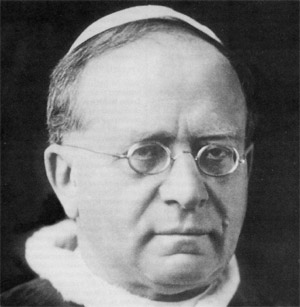 1923-1924 Kirsch held a course at the Campo Santo Teutonico for young scholars interested in Christian archaeology with the approval of Pius XI, who had already spoken to him a year earlier about his intention to found the Pontificio Istituto di Archeologia Cristiana (he continued such private courses until 1925). In August 1924, Cardinal Franz Ehrle wrote to him that Pius XI wished him to stay longer in Rome to help found the Institute. Kirsch himself stated that he alone, together with Pius XI, had determined the statutes and professors of the Pontificio Istituto di Archeologia Cristiana to be founded. Neither he nor Eugenio Pacelli mention Angelo Silvagni, from whom, however, the Pontificia Commissione di Archeologia Sacra had already given Benedict XV the first impulses for such an institute in 1919. Kirsch became the founding rector and remained a formative figure of the new Pontificio Istituto di Archeologia Cristiana (via Napoleone III, 1) until his death.
1923-1924 Kirsch held a course at the Campo Santo Teutonico for young scholars interested in Christian archaeology with the approval of Pius XI, who had already spoken to him a year earlier about his intention to found the Pontificio Istituto di Archeologia Cristiana (he continued such private courses until 1925). In August 1924, Cardinal Franz Ehrle wrote to him that Pius XI wished him to stay longer in Rome to help found the Institute. Kirsch himself stated that he alone, together with Pius XI, had determined the statutes and professors of the Pontificio Istituto di Archeologia Cristiana to be founded. Neither he nor Eugenio Pacelli mention Angelo Silvagni, from whom, however, the Pontificia Commissione di Archeologia Sacra had already given Benedict XV the first impulses for such an institute in 1919. Kirsch became the founding rector and remained a formative figure of the new Pontificio Istituto di Archeologia Cristiana (via Napoleone III, 1) until his death.
Kirsch lectured in Fribourg for the summer semester and at the Pontificio Istituto di Archeologia Cristiana for the winter semester until 1932, while living at the Campo Santo Teutonico (on leave from teaching in Fribourg 1926-1928, 1930-1931, honorary professorship since 1934). In his absence from Rome, Eduard Junyent took over his teaching duties at the Pontificio Istituto di Archeologia Cristiana. In July 1932 he submitted his resignation as full professor in Fribourg and moved permanently to Rome, where he lived from about May 1933 onwards because of his extensive library at via Ruggero Bonghi 9. In 1935 Kirsch brought the venerable institution of the lectures of the Società dei Cultori di Archeologia Cristiana to a halt, at which he himself had lectured several times, when he demanded that they be held at the Pontificio Istituto di Archeologia Cristiana.
Overall, Kirsch was a generalist, bibliographer and compiler in his Christian archaeological work, not a basic researcher. This becomes even clearer from his immense unpublished archive material. Nevertheless, he tried to give the Institute a scientific direction by making the Roman title churches and deaconries a main field of work. His theories that the title churches went back to pre-Constantine domus ecclesiae and only took on the patronage of saints in the course of the 6th century became authoritative for many decades. He promoted corresponding studies by Adolf Kalsbach, Gastone Baldracco, Heinrich Bretzler, Maurice Mesnard, Eduard Junyent, René Vielliard and Jean Lestocquoy.
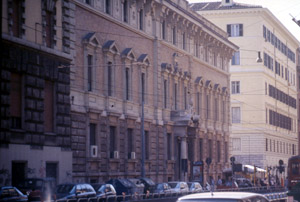 With the 4th International Congress of Christian Archaeology in 1938 in the Vatican, which dealt with church architecture, its zenith had admittedly long since passed. No more decisive impulses could be expected from the Roman school of Christian archaeology, which was too focused on Rome itself, and the Second World War contributed to the Pontificio Istituto di Archeologia Cristiana falling into a long, existential crisis after Kirsch's death. His sociability - acquaintances since his earliest Roman days with Giovanni Battista de Rossi, Enrico Stevenson, Orazio Marucchi, Franz Xaver Kraus, Heinrich Swoboda, Albert Ehrhard and many others - is documented in numerous letters from his pen. He often met with friends (Ehses, Wilpert, Denifle and others) in the summer at his wealthy brother Nikolaus Kirsch (Puricelli) at the Rheinböllerhütte (Hunsrück) or at Burg Reichenstein on the Rhine. Kirsch was completely selfless, took care of all matters for which he had taken responsibility with unwavering conscientiousness, knew no airs and was called "Papa Kirsch" by the Camposantines because of his kindness. A few months before his death, Kirsch moved into the Villa S. Francesco, where he died. Angelo Silvagni had previously managed the affairs of the Pontificio Istituto di Archeologia Cristiana as pro-rector until Pio Franchi de'Cavalieri was appointed rector. In his will of 14.03.1937, Kirsch appointed the Holy See as universal heir in favour of the Pontificio Istituto di Archeologia Cristiana. His library, which had been collected not least through countless reviews, and his estate were thus transferred to the Pontificio Istituto di Archeologia Cristiana. Part of the library was to be ceded to the Campo Santo Teutonico.
With the 4th International Congress of Christian Archaeology in 1938 in the Vatican, which dealt with church architecture, its zenith had admittedly long since passed. No more decisive impulses could be expected from the Roman school of Christian archaeology, which was too focused on Rome itself, and the Second World War contributed to the Pontificio Istituto di Archeologia Cristiana falling into a long, existential crisis after Kirsch's death. His sociability - acquaintances since his earliest Roman days with Giovanni Battista de Rossi, Enrico Stevenson, Orazio Marucchi, Franz Xaver Kraus, Heinrich Swoboda, Albert Ehrhard and many others - is documented in numerous letters from his pen. He often met with friends (Ehses, Wilpert, Denifle and others) in the summer at his wealthy brother Nikolaus Kirsch (Puricelli) at the Rheinböllerhütte (Hunsrück) or at Burg Reichenstein on the Rhine. Kirsch was completely selfless, took care of all matters for which he had taken responsibility with unwavering conscientiousness, knew no airs and was called "Papa Kirsch" by the Camposantines because of his kindness. A few months before his death, Kirsch moved into the Villa S. Francesco, where he died. Angelo Silvagni had previously managed the affairs of the Pontificio Istituto di Archeologia Cristiana as pro-rector until Pio Franchi de'Cavalieri was appointed rector. In his will of 14.03.1937, Kirsch appointed the Holy See as universal heir in favour of the Pontificio Istituto di Archeologia Cristiana. His library, which had been collected not least through countless reviews, and his estate were thus transferred to the Pontificio Istituto di Archeologia Cristiana. Part of the library was to be ceded to the Campo Santo Teutonico.
- Details
- Category: Former Directors
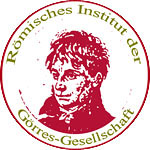 Römisches Institut der Görres-Gesellschaft
Römisches Institut der Görres-Gesellschaft







